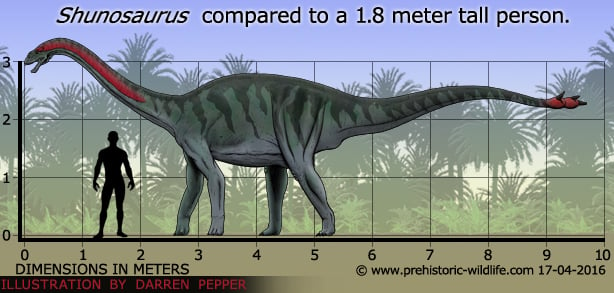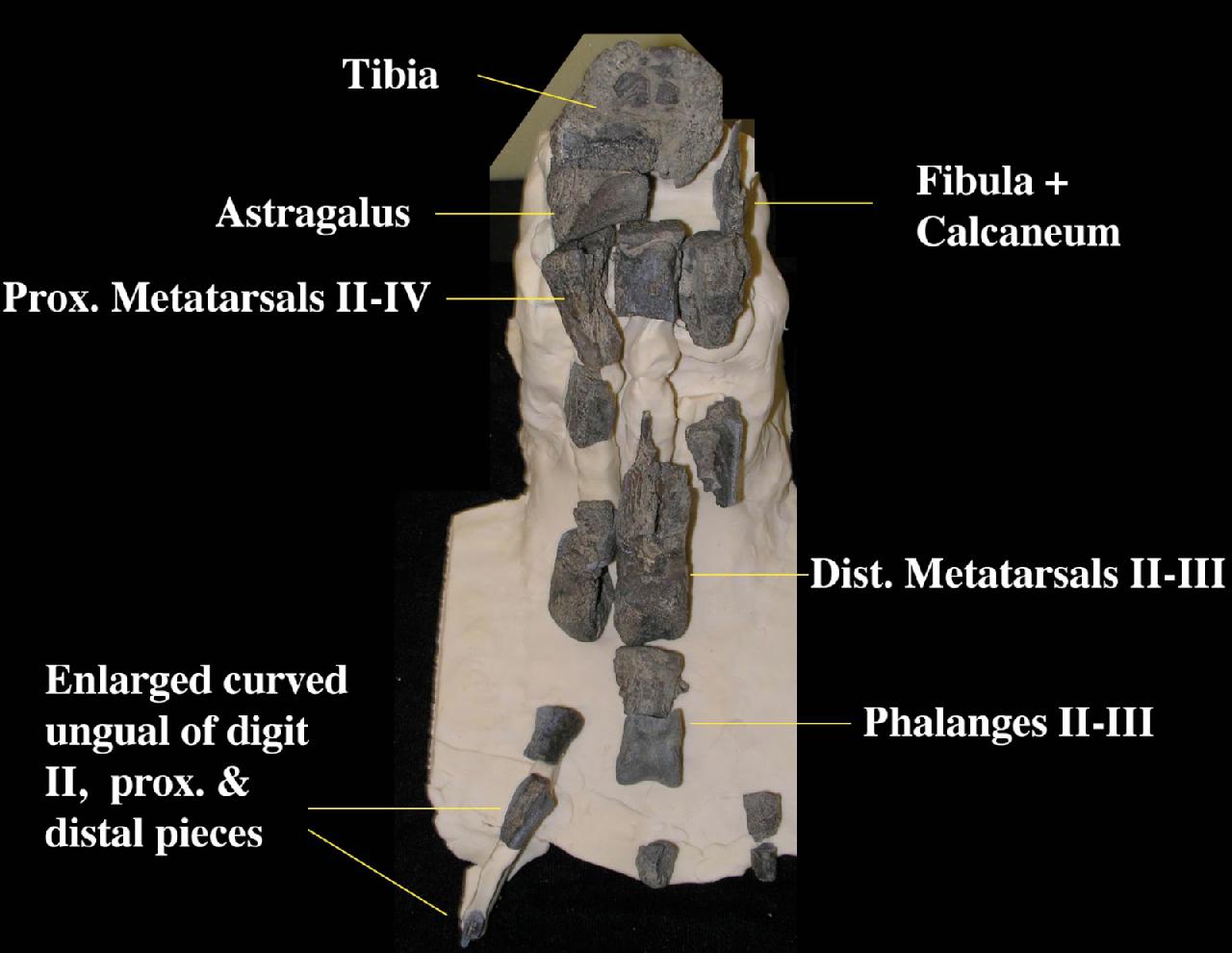|
|
Post by Talira Greycrest on Nov 9, 2021 5:42:18 GMT
Name: StyxosaurusPronunciation: Sticks-oh-sore-usMeaning of name: "Styx lizard", after the mythological River Styx which separated the Greek underworld from the world of the living.Species: S. snowii, S. browniSize: Measured between 11 and 12 metres long, half of that length being composed of its neck. Weighed around 4 metric tonnes.Family: ElasmosauridaeDiet: PiscivoreFirst fossils found: Known from two specimens including a mostly complete skeleton. Originally named as a species of Cimoliasaurus by Samuel Wendell Williston in 1890 before being re-named as a species of Elasmosaurus in 1906. S. snowii named by American palaeontologist, Samuel Paul Welles, in 1890. S. browni also named by Mr. Welles in 1943.Lived: 83.6 to 72.1 million years ago during the Campanian stage of the Late Cretaceous in the Western Interior Seaway which once covered the middle of what is now the United States.

|
|
|
|
Post by Joey12 on Nov 9, 2021 11:59:54 GMT
That's a mighty long neck 6 meters of neck. It better stay in the water to float that thing.
|
|
Tix Mascot
Tech guru
Italy is my second homeland
Posts: 11,089  Mini-Profile Background: {"image":"http://4.bp.blogspot.com/-X5mhw13BJ7Y/TwKeZ3uM7YI/AAAAAAAABPw/D82go4Ny_8E/s1600/italy-background-8-787281.jpg","color":""}
Mini-Profile Text Color: 0ef8f1
Mini-Profile Name Color: f40d39
Year of Birth: 1961
Nationality: Norwegian
Mini-Profile Background: {"image":"http://4.bp.blogspot.com/-X5mhw13BJ7Y/TwKeZ3uM7YI/AAAAAAAABPw/D82go4Ny_8E/s1600/italy-background-8-787281.jpg","color":""}
Mini-Profile Text Color: 0ef8f1
Mini-Profile Name Color: f40d39
Year of Birth: 1961
Nationality: Norwegian
|
Post by Tix Mascot on Nov 9, 2021 16:03:09 GMT
I wonder what advantage such a long neck had.
|
|
|
|
Post by Talira Greycrest on Nov 9, 2021 21:04:57 GMT
I wonder what advantage such a long neck had. Your body can be in one place whilst your head is somewhere else. |
|
|
|
Post by Talira Greycrest on Nov 10, 2021 7:28:42 GMT
Name: DakotadonPronunciation: Dah-koh-tah-donMeaning of name: "Dakota tooth"Species: D. lakotaensisSize: Unknown due to a lack of fossils.Family: Uncertain. Possible Iguanodontid.Diet: Herbivore. Likely fed on both high and low-growing vegetation.First fossils found: Known only from a single, partial skull discovered in the Lakota Formation of South Dakota in 1989. Named in the same year by Gregory Scott Paul. Was originally thought to be a species of Iguanodon.Lived: 129.4 to 125 million years ago during the Barremian stage of the Early Cretaceous in what is now the Upper Midwest region of the United States. Dakotadon fossils Dakotadon fossils
|
|
|
|
Post by Talira Greycrest on Nov 11, 2021 6:49:56 GMT
Name: ShunosaurusPronunciation: Shu-no-sore-usMeaning of name: "Shu lizard", in reference to the ancient name for Sichuan Province, southwest China, where its fossils were discovered.
Species: S. lii
Size: Between 9 and 10 metres long, between 3 and 4 metres tall and weighing around 3 metric tonnes.Family: Uncertain. Possibly either a Cetiosaurid or a Euhelopodid.Diet: Herbivore. Fed on both high and low-growing vegetation.
First fossils found: Known from several specimens, the first of which was discovered in the Xiashaximiao Formation of Sichuan Province, southwest China, in 1977. Named by Chinese palaeontologists Dong Zhiming, Zhou Shiwu and Zhang Yihong in 1983. The most remarkable feature of this Sauropod is the spiked club on the end of the tail which may have been used for defense or between two males competing for dominance.
Lived: 168 to 163.5 million years ago during the Bathonian and Callovian stages of the Middle Jurassic in what is now southwest China.

|
|
|
|
Post by Joey12 on Nov 11, 2021 6:51:26 GMT
Not sure what to make of these.
|
|
|
|
Post by Talira Greycrest on Nov 12, 2021 7:38:04 GMT
Name: PyroraptorPronunciation: Pie-roe-rap-torMeaning of name: "Fire thief", due to its fossils being discovered after a forest fire.Species: P. olympiusSize: Uncertain due to a lack of fossilsFamily: DromaeosauridaeDiet: CarnivoreFirst fossils found: Known only from a single, fragmentary skeleton discovered in southeastern France in 1992. Named by French paleontologists, Ronan Allain and Philippe Taquet, in 2000.Lived: 73 to 70.6 million years ago during the Campanian and Maastrichtian stages of the Late Cretaceous in what is now southeastern France. Estimated size of Pyroraptor compared to a human Estimated size of Pyroraptor compared to a human
|
|
|
|
Post by Joey12 on Nov 13, 2021 5:55:29 GMT
Interesting arms and feet.
|
|
|
|
Post by Talira Greycrest on Nov 13, 2021 9:19:31 GMT
Name: ImperobatorPronunciation: Im-pe-ro-ba-torMeaning of name: "Powerful warrior"Species: I. antarcticusSize: Uncertain due to a lack of fossils.Family: UncertainDiet: CarnivoreFirst fossils found: Known only from a partial left foot discovered in the Snow Hill Island Formation of James Ross Island, Antarctica, in 2003. Named by R. C. Ely and J. A. Case in 2019.Lived: 70.6 to 66 million years ago during the Maastrichtian stage of the Late Cretaceous in what is now Antarctica.

|
|
|
|
Post by Joey12 on Nov 14, 2021 3:05:14 GMT
The first Big Foot.
|
|
|
|
Post by Talira Greycrest on Nov 14, 2021 5:20:04 GMT
Name: SinocalliopteryxPronunciation: Sigh-no-cal-ee-op-ter-ixMeaning of name: "Chinese beautiful feather"Species: S. gigasSize: Measured around 2.37 metres long, 0.7 metres tall and weighing around 20kgs. Largest-known Compsognathid.Family: CompsognathidaeDiet: CarnivoreFirst fossils found: Known only from a single, almost-complete skeleton discovered in the Yixian Formation of Liaoning Province, northeast China (date of discovery uncertain). Named by Chinese palaeontologists, Ji Shu'an, Ji Qiang, Lü Junchang and Yuan Chongx, in 2007.Lived: 124.6 million years ago during the Aptian stage of the Early Cretaceous in what is now northeast China.

|
|
|
|
Post by Joey12 on Nov 14, 2021 20:22:21 GMT
Not sure if I would want them around me.
|
|
|
|
Post by Talira Greycrest on Nov 15, 2021 6:56:32 GMT
Name: MapusaurusPronunciation: Mah-puh-sore-usMeaning of name: "Earth lizard"Species: M. roseaeSize: Between 10 and 13 metres long, 4 metres tall and weighing 3 metric tonnes.Family: Giganotosaurinae (a sub-family of Carcharodontosauridae)Diet: CarnivoreFirst fossils found: Known from a bonebed containing at least seven individuals discovered in the Huincul Formation of northern Patagonia, Argentina, and excavated between 1997 and 2001, by the Argentinian-Canadian Dinosaur Project. Named by Canadian palaeontologist, Philip John Currie, and Argentinian palaeontologist, Rodolfo Aníbal Coria, in 2006.Lived: 97 to 93 million years ago during the Cenomanian and Turonian stages of the Late Cretaceous in what is now northern Patagonia, Argentina.

|
|
|
|
Post by Joey12 on Nov 15, 2021 9:15:45 GMT
Wow for as big as it is I would think it would have more muscular legs. Big head too.
|
|